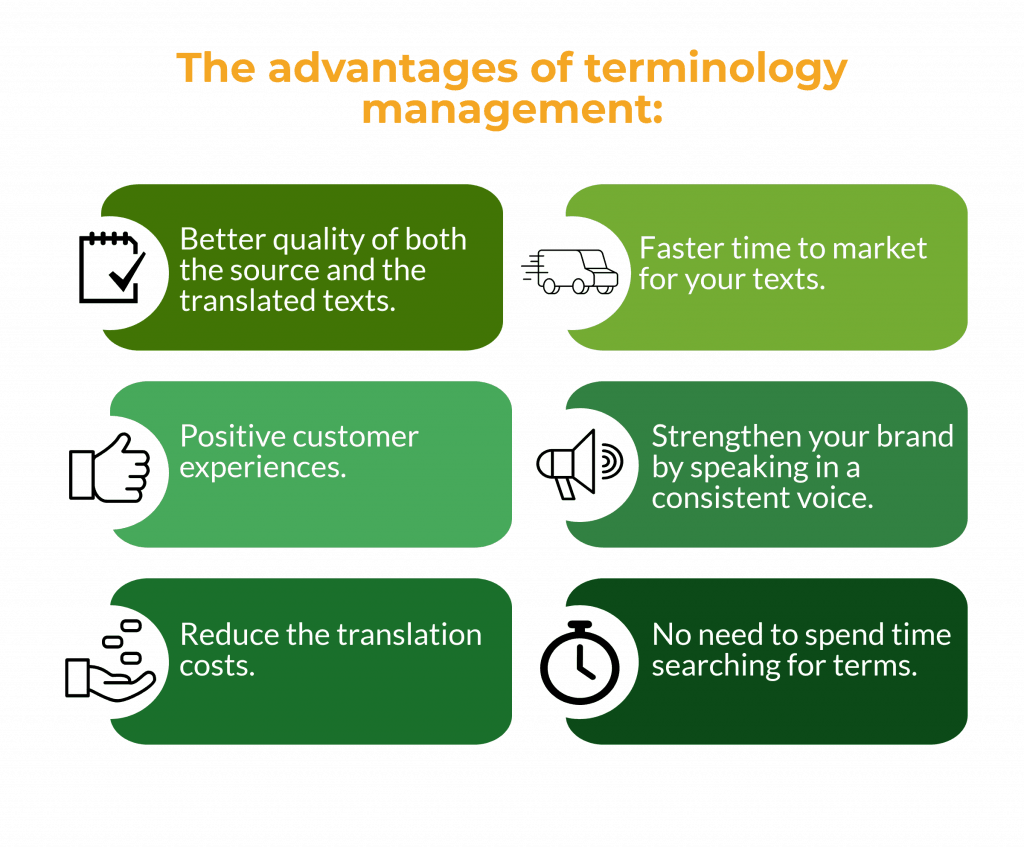A study made by the International Association for Technical Communication, Tekom, covering 1,000 of its members, demonstrates conclusively that there are clear advantages to managing the terminology in your company. It costs both time and money when terminology is not standardised. Despite this, most companies still either choose not to invest at all or only to invest small amounts in their terminology work.
This may be due to the fact that some of the advantages in having a consistent terminology can be difficult to measure. Additionally, it may appear as an insurmountable task that is difficult to get started on – or maybe it is hard to figure out how exactly to tackle it.
In this blog post, you can read about some of the things that can go wrong when your company fails to manage its terminology. Among other things, these arguments can be used to convince the leaders of the company to divert the required resources to the terminology work. Finally, you can read about the advantages that using a consistent terminology provides to your company, your employees and your translators.
What challenges can inconsistent or incorrect terminology lead to for your company?
It is not good communication if different terms are being used for things and concepts that are central to the company’s business. Some of the obvious challenges this can result in are:
- It can lead to misunderstandings
Specifically, it can be difficult for the recipient to decipher what the sender is trying to say if different terms are used for the same thing. According to the study by Tekom, this happens frequently, as 57% responded that departments and employees either regularly or very often use different terminology.
Inconsistent terminology that leads to misunderstandings also results in the receiver having to spend more time reading and trying to understand the text.
- It can give a negative impression of the sender
If a company has no control over what it calls its products or services, it can be difficult for the receiver to trust the company. It leaves the receiver with a bad impression which can damage the company’s brand and image, and it can result in lower revenues or loss of market share. However, this is difficult to measure directly.
- It steals time from the employees
When the company does not manage its terminology in a term base or a glossary, the employees have to spend extra time searching for the correct word. The same goes for external translators. It is a far better use of their time if they are working on crafting a high-quality and well-written text rather than spending their time searching for the correct terminology.
On top of that, you need to spend more time on the internal proofreading of documents if the terminology needs to be checked extra carefully and there are a lot of issues to fix. This may lead to several rounds of proofreading being needed.
Also, terminology often ends up as a subject for internal discussions between departments – which could have been avoided if it had been decided once and for all what to call something.
What advantages does it bring to your company when you manage your terminology?
The use of consistent terminology in your company’s communications brings clear advantages. The most important ones are:
- The quality improves
Clear and successful communication contributes towards creating a positive customer experience that simultaneously strengthens your brand and creates loyalty. This requires high-quality documents, and this is where consistent terminology becomes very important. This is also confirmed by 84% of the people asked in the Tekom study, and it highlights the fact that the most significant advantage associated with terminology work is that there is a huge improvement in quality.* And when quality improves, this triggers a domino effect of other advantages that save the company both time and money (read more below).
- It saves time and increases efficiency
When the terminology is contained in a structured system, it becomes much faster for writers to craft their texts, but it also becomes faster for the translators to translate them and for the proof-readers to perform the final proofreading. This is also confirmed by the people asked in the Tekom study – most of them emphasise that they save time when it is clear what terminology they should use. They save time on such simple things as not having to ask for clarification, and it all adds up to make a huge difference.
And when you save time, you also save money, and this is especially the case when you handle the language jobs internally. Additionally, it speeds up the entire process, so you get shorter delivery times and a faster time to market.
- It saves money
You save money throughout the entire chain of producing content when you manage your terminology. One significant factor is that it becomes cheaper to get your texts translated. It becomes cheaper because there will be a higher so-called “match rate” in the translation tool, and this results in a lower price.
The figures that appear in the Tekom study list an overall savings rate of 30% as a direct consequence of the terminology work.* This number is worth keeping in mind when you need to decide how many resources to devote to starting up the project or to invest in the necessary technology.
It is advisable to make a thorough cost-benefit analysis of the terminology work. In this article (http://www.tcworld.info/e-magazine/content-strategies/article/tekom-study-cost-and-effectiveness-of-terminology-work/) you can get inspiration for what this cost-benefit analysis should contain.
There are thus clear advantages associated with managing the terminology in a company, and these advantages improve the company’s image while simultaneously saving it time and resources. But why then is it still such an uphill battle to get companies to dedicate the necessary time and resources to the terminology project? One of the reasons might be that many do not even know where to get started. In our next blog post, “Terminology management – Part 2”, we will give you some tips on how to get started with the process.










